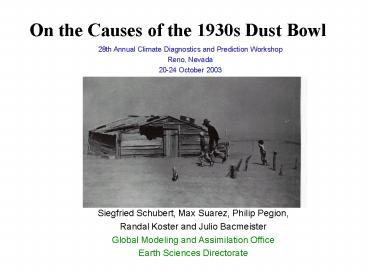On the Causes of the 1930s Dust Bowl - PowerPoint PPT Presentation
1 / 25
Title:
On the Causes of the 1930s Dust Bowl
Description:
On the Causes of the 1930s Dust Bowl 28th Annual Climate Diagnostics and Prediction Workshop Reno, Nevada 20-24 October 2003 Siegfried Schubert, Max Suarez, Philip ... – PowerPoint PPT presentation
Number of Views:25
Avg rating:3.0/5.0
Title: On the Causes of the 1930s Dust Bowl
1
On the Causes of the 1930s Dust Bowl
28th Annual Climate Diagnostics and Prediction
Workshop Reno, Nevada 20-24 October 2003
- Siegfried Schubert, Max Suarez, Philip Pegion,
- Randal Koster and Julio Bacmeister
- Global Modeling and Assimilation Office
- Earth Sciences Directorate
2
The Dust Bowl
- What is the role of SSTs?
- - different ocean basins
- - extratropical versus tropical
- II. Are land/atmosphere feedbacks important?
- How is it different from other Great Plains
droughts of the 20th century? - IV. Can we predict the next one?
3
AGCM NSIPP-1 (NASA S-I Prediction
Project) Climatology and Skill (Bacmeister et
al. 2000, Pegion et al. 2000, Schubert et al.
2002) Global grid point dynamical core, 4rth
Order (Suarez and Takacs 1995) Relaxed
Arakawa-Schubert Convection (Moorthi and Suarez
1992) Shortwave/Longwave Radiation (Chou et al.
1994, 1999) Mosaic interactive land model
(Koster and Suarez 1992, 1996) 1st Order PBL
Turbulence Closure (Louis et al. 1982) AGCM runs
with Specified SST (C20C project) HadISST and
sea ice dataset (1902-1999) 14 ensemble members
- same SST, different ICs Model resolution 3
degree latitude by 3.75 degree longitude (34
levels)
4
The Dust Bowl
5
(No Transcript)
6
(No Transcript)
7
(No Transcript)
8
(No Transcript)
9
(No Transcript)
10
(No Transcript)
11
(No Transcript)
12
(No Transcript)
13
(No Transcript)
14
(No Transcript)
15
Other Droughts
16
?
Corr0.57
17
(No Transcript)
18
Low Pass EOF 1 (Trend)
Low Pass EOF 2 (PPP)
Residual EOF 1 (ENSO)
PC Time Series
ENSO
PPP
Trend
19
Correlation between PPP and Great Plains
Precipitation (low frequency -gt 6 years and
longer) Individual ensemble member
precipitation Min 0.31 max 0.70, Ensemble
mean precipitation ( 0.74) Observed
precipitation ( 0.41)
20
1970s Dust Bowl?
21
Borchert, John R. The Dust Bowl of the 1970s,
AAAG, vol 61, March 1971
ABSTRACT Major droughts in the Grassland region
of the central United States have occurred
rhythmically during the period of the
instrumental record. The time for the next one
may be near. .
22
By mid February of 1977 the midwestern US was
experiencing one of the most severe droughts in
its recorded history dramatic dust storms blew
up in eastern Colorado and western Kansas and
Oklahoma drought was actually most severe in
Minnesota and Dakotas By the fall of 1977 the
general drought picture . had changed
significantly
Symposium on North American Droughts - February
21 1977 (Introduction by Norman Rosenberg, AAAS
Selected Symposium 15)
23
(No Transcript)
24
(No Transcript)
25
Conclusions based AGCM Results
- Tropical SST anomalies and land/atmosphere
feedbacks caused the 1930s dust bowl - All three tropical ocean basins played a role
- Cool Pacific and Indian (remote response - upper
level flow) - Warm Atlantic (local response - upper and low
level flow) - Extra-tropical SSTs acted to extend the drought
to the east - The SST forcing of the Dust Bowl differs from
that of other major droughts (1910s and 1950s
where the Pan Pacific Pattern of SST is the main
driver) - Predicting future Dust Bowls/droughts need
better coupled models with improved simulation of
decadal ocean variability, and reduced
uncertainty in land/atmosphere coupling also
need better understanding of role of ENSO and
global warming































